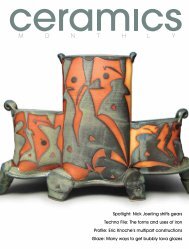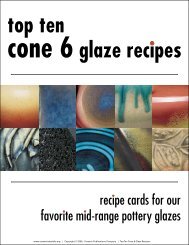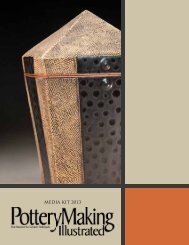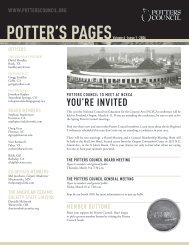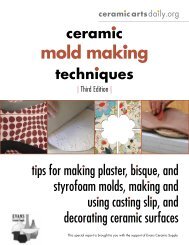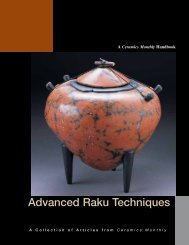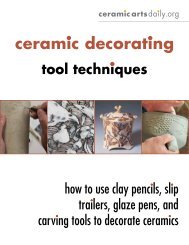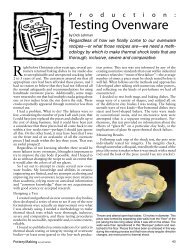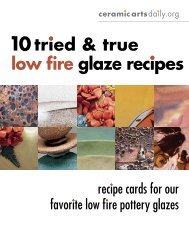Techniques - Ceramic Arts Daily
Techniques - Ceramic Arts Daily
Techniques - Ceramic Arts Daily
You also want an ePaper? Increase the reach of your titles
YUMPU automatically turns print PDFs into web optimized ePapers that Google loves.
experiments involved firing cone<br />
10 glaze recipes only to cone 6.<br />
These tests resulted in the discovery<br />
that crystalline glazes could be<br />
produced in this lower temperature<br />
range by simply introducing<br />
additional fluxes. The flux that<br />
seemed to produce the best results<br />
was lithium carbonate. Other<br />
materials that would function as a<br />
powerful flux were either soluble<br />
or contained additional silica and<br />
alumina, which are not desirable<br />
in crystalline glazes.<br />
All of my experiments with crystalline<br />
glaze firings, up until fall<br />
2006, have been done in a manually<br />
operated electric kiln. The<br />
kiln has infinite controls, so with<br />
careful monitoring, I was able to<br />
control the firing schedule fairly<br />
accurately. A digital pyrometer is<br />
an essential tool to closely track<br />
temperature changes, especially<br />
during long holding cycles. Acquisition<br />
of my first kiln with a programmable<br />
controller has allowed<br />
for more complicated, repeatable<br />
firing schedules. The ability to be<br />
able to alter temperature ramp<br />
speeds and specific temperature<br />
hold times have opened up new<br />
avenues of experimentation. I<br />
have also found that, for both<br />
types of kilns, a direct vent system<br />
is important for rapid cooling<br />
cycles and maintaining an oxidizing<br />
atmosphere.<br />
Crystalline<br />
Technique<br />
I’ve developed techniques through<br />
years of experimentation, adopting<br />
processes that worked, eliminating<br />
those that produced only limited<br />
success. Web searches and recent<br />
publications provide a variety of<br />
approaches to this very involved<br />
process, and each individual needs<br />
to conduct tests to find the process<br />
that makes the most sense for his<br />
or her particular circumstances.<br />
Crystalline glazes produce the<br />
best results when applied to a<br />
smooth white clay body. Many<br />
artisans work with a porcelain<br />
clay body. Porcelain comes with its<br />
own set of issues and I have found<br />
a cone 10 porcelaneous stoneware<br />
clay—B-Mix or Bee-Mix—that<br />
works very well with my glazes.<br />
I chose to use a cone 10 clay to<br />
reduce the amount of alumina that<br />
might be picked up by the glaze.<br />
A normal glaze has a mix of<br />
silica/flux/alumina in a ratio that<br />
provides a glassy surface and<br />
remains in place when melted on<br />
a vertical surface. A crystalline<br />
glaze contains little or no alumina,<br />
which would inhibit crystal<br />
growth. The glaze is comprised of<br />
silica, flux and a saturation of zinc<br />
oxide. This highly fluxed mix of<br />
materials leads to a very fluid glaze<br />
and steps must be taken to avoid<br />
destroying kiln shelves or the kiln.<br />
Catch Basins<br />
and Pedestals<br />
Every pot must have its own catch<br />
plate/basin to contain the glaze<br />
that runs off the pot. The catch<br />
plate need not be made from the<br />
same clay as the pot. The plate can<br />
be wheel thrown or hand built.<br />
Each pot must also have some type<br />
of pedestal device to facilitate re-<br />
www.ceramicartsdaily.org | Copyright © 2010, <strong>Ceramic</strong> Publications Company | Three Great <strong>Ceramic</strong> Glazing <strong>Techniques</strong> | 14



